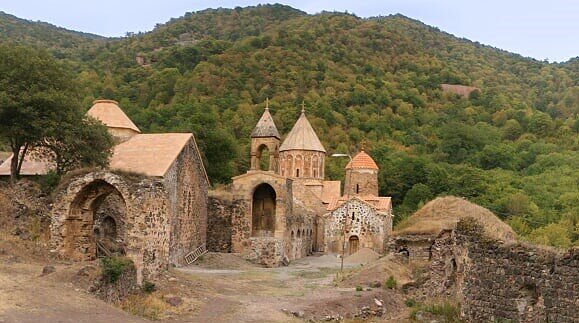This region of historic Armenia which is at the epicentre of the current war raging in South Caucasus has a long history. In Urartian inscriptions (9th to 6th centuries BCE) it appears as the toponyms Ardakh, Urdekhe and Atakhuni. The Greek geographer Strabo (c. 63 BCE-c. 23 CE) calls the region Orchistenê, a province of Armenia which furnishes large bodies of cavalry. In fact, the Artsakh cavalry took a prominent part at the Battle of Avarayr against Sasanian Persia in 451 CE. After the fall of Urartu, Artsakh is mentioned as the 10th province of Greater Armenia which emerged as a state on the Armenian Highlands from the 2nd century BCE. The first bishop of Artsakh was Grigoris, the grandson of St Gregory the Illuminator. He played an important role in the Christianisation of Artsakh, the adjoining province of Utik and the neighbouring country of Caucasian Albania, the territory of which corresponds to the modern Republic of Azerbaijan. The present-day monastery of Amaras in Artsakh marks the burial place of Grigoris who died a martyr. Mesrop Mashtots, the inventor of the Armenian alphabet, founded one of the first Armenian schools in Artsakh to educate the children of the province and through them help establish the new religion of Christianity more firmly in the region.
After the demise of the Armenian Arsacid kingdom in the 5th century, Artsakh became part of the Persian marzpanate (border province) of Albania and suffered the invasion of the Khazars from the north before falling under Arab rule in the 7th century. Artsakh regained a semi-autonomous status under the Bagratuni kings of Armenia (9th to 11th centuries) forming the vassal kingdom of Khachen. From the beginning of the 11th century the region increasingly became known as Khachen and Artsakh ceased to be known as a distinct administrative region; it survived as a mere geographical toponym until the Republic of Nagorno-Karabakh officially renamed the state Artsakh in 2017. The Middle Ages saw a flourishing of arts and spirituality with the founding of various monasteries and scriptoria, producing a great variety of manuscripts with a distinct regional style of book illumination.
In the early 11th century the invasion of Seljuk Turks resulted in the first settlements of Turkish tribes in the lowlands of eastern Artsakh. Over a century later, the Mongol invasion of Armenia put an end to the semi-independent status of Khachen, culminating in the devastating conquest of the region by Tamerlane in the late 14th century. There followed the domination by White Sheep and Black Sheep Turkomans which resulted in further fragmentation of the Armenian princedom of Khachen into smaller administrative units known as melikdoms ruled by a hereditary melik. From the late 14th century onwards, the region became known as Karabagh (from Turkish ‘kara’, meaning either ‘black’ or ‘big’ and Persian ‘bagh’, meaning ‘garden’), a name that has survived to the 21st century in all regional languages, including Armenian, and also in the Soviet Russian name for the autonomous region of Nagorno-Karabakh (mountainous Karabagh).
From the end of the 16th century to the beginning of the 19th century the melikdoms in the mountainous regions of Artsakh and the adjoining Armenian province of Syunik led a semi-independent existence, mostly under the suzerainty of Persian shahs. The Russian Empire, expanding southwards under Tsar Alexander I, annexed the territory of Artsakh in 1805. Thereafter, the region was incorporated in the newly created province of Elizavetpol. The Armenian regions to the west of Artsakh, namely Yerevan and Nakhichevan, were annexed by the Russians some 20 years later and formed part of the sort-lived Armenian Province, later morphed into the Erivan Governorate. In placing East Armenia and Artsakh in different imperial provinces in the early 19th century, the Russian colonial administrators thus wittingly or unwittingly sowed the seeds of future problems in the region.
By Gagik Stepan-Sarkissian, AI librarian and research advisor

